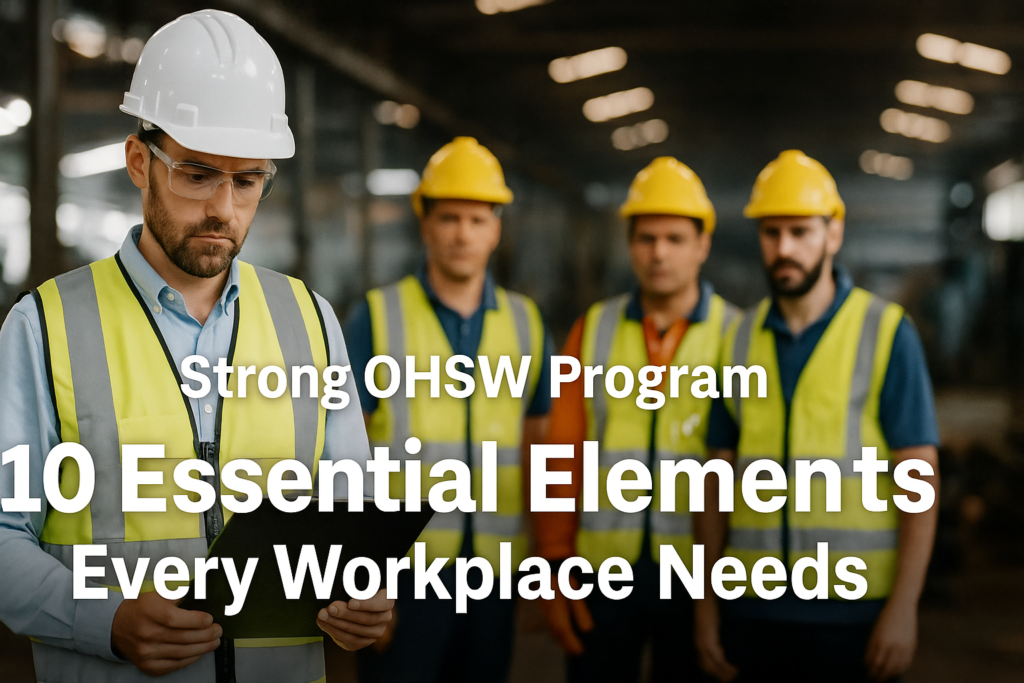A Strong OHSW Program is more than just compliance—it’s a commitment to protecting workers’ physical and mental health.

Whether you’re managing a construction site, healthcare facility, or an office setting, implementing these ten essential elements will establish a culture of safety and wellbeing that benefits everyone.
1. Leadership Commitment
An effective OHSW program starts at the top. Leaders must demonstrate a visible, ongoing commitment to workplace health and safety.
This includes allocating resources, setting clear expectations, and modeling safe behaviors. When leadership genuinely supports safety, employees are more likely to follow suit.
2. Worker Participation
Safety isn’t just the responsibility of management. Employees must be actively involved in hazard identification, safety committees, and decision-making.
When workers participate, they’re more invested in outcomes and help spot risks that leadership might miss.
Internal link idea: Include reference to your site’s safety committee policy or worker involvement page.
3. Hazard Identification and Risk Assessment
A Strong OHSW Program must include a systematic approach to identifying hazards and assessing risks.
This means conducting regular workplace inspections, using tools like Job Hazard Analysis (JHA), and documenting near misses and incidents.
External resource: Safe Work Australia – Risk Management (DoFollow)
4. Clear Roles and Responsibilities
Everyone should know their role in promoting a safe and healthy work environment. From supervisors to contractors, clear responsibilities ensure accountability and action.
Job descriptions, onboarding materials, and safety manuals should all reinforce these roles.
5. Training and Competency
A Strong OHSW Program must prioritize ongoing safety training. New employees need robust onboarding, while experienced staff need refreshers.
Training should also cover emergency procedures, hazard recognition, and specific job-related risks.
External tool: Consider platforms like iHASCO (DoFollow) for accessible, online training content.
6. Effective Communication
Safety messages must be communicated clearly and regularly. This includes daily toolbox talks, bulletin board updates, safety alerts, and incident debriefings.
Two-way communication is also crucial—workers need a safe space to voice concerns.
7. Incident Investigation and Reporting
Every near miss, injury, or safety breach should be documented and thoroughly investigated. The goal is not blame—but learning.
Proper root cause analysis helps prevent recurrence and demonstrates the seriousness of your safety commitment.
8. Continuous Improvement
A Strong OHSW Program evolves. Use feedback, audits, inspections, and performance metrics to identify weaknesses and opportunities. Implement corrective actions and review policies frequently to stay current with legal requirements and best practices.
Internal link idea: Reference your site’s annual safety performance report or audit process.
9. Mental Health and Wellbeing Support
Occupational safety isn’t only physical. A truly robust program addresses mental health, stress management, and work-life balance. Provide access to Employee Assistance Programs (EAP), promote healthy workloads, and reduce psychosocial hazards.
External resource: Mind – Workplace Wellbeing Resources (DoFollow)
10. Emergency Preparedness and Response
No OHSW program is complete without a tested emergency response plan. Fire drills, first aid procedures, evacuation plans, and crisis communication protocols ensure readiness for any emergency—be it a medical incident, fire, or natural disaster.
Summary Table: 10 Essential OHSW Program Elements
| # | Element | Purpose |
|---|---|---|
| 1 | Leadership Commitment | Sets the tone for organizational safety culture |
| 2 | Worker Participation | Enhances ownership and real-world insight |
| 3 | Hazard Identification & Risk Assessment | Detects and prevents potential harm |
| 4 | Roles and Responsibilities | Ensures accountability at all levels |
| 5 | Training and Competency | Builds skill and awareness among workers |
| 6 | Communication | Maintains transparency and awareness |
| 7 | Incident Reporting & Investigation | Enables learning and correction |
| 8 | Continuous Improvement | Drives long-term success and adaptation |
| 9 | Mental Health & Wellbeing | Protects emotional and psychological health |
| 10 | Emergency Preparedness | Equips the workforce to respond effectively to crises |
Final Thoughts on Building a Strong OHSW Program
A Strong OHSW Program protects not only your team—but your entire organization. By embedding safety and wellbeing into every layer of operations, you reduce injuries, boost morale, and strengthen compliance.
Start with these 10 essentials and commit to constant improvement. The investment in safety today protects your workplace tomorrow.
Leave a Reply